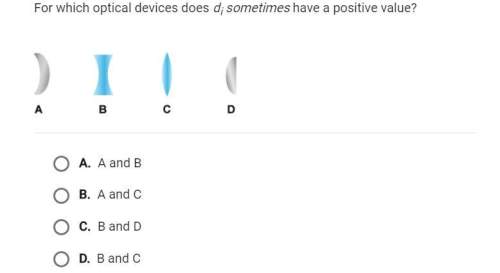
Physics, 23.11.2020 04:00 destinywyatt9129
Temperatures of gases inside the combustion chamber of a four‑stroke automobile engine can reach up to 1000°C. To remove this enormous amount of heat, the engine utilizes a closed liquid‑cooled system that relies on conduction to transfer heat from the engine block into the liquid and then into the atmosphere by flowing coolant around the outside surface of each cylinder.
Suppose that, in a particular 4‑cylinder engine, each cylinder has a diameter of 8.75 cm, a height of 11.3 cm, and a thickness of 3.14 mm. The temperature on the inside of the cylinders is 195.2°C, and the temperature outside, where the coolant passes, is 130.0°C. The temperature of the incoming liquid (a mixture of water and antifreeze) is maintained at 95.0°C.
What volume flow rate of coolant  would be required to cool this engine? Assume that the coolant reaches thermal equilibrium with the outer cylinder walls before exiting the engine. The specific heat of the coolant is 3.75 J/g°C and its density is 1.070×103 kg/m3. The cylinder walls have thermal conductivity of 1.10×102 W/m⋅∘C. Assume that no heat passes through the ends of the cylinders.
would be required to cool this engine? Assume that the coolant reaches thermal equilibrium with the outer cylinder walls before exiting the engine. The specific heat of the coolant is 3.75 J/g°C and its density is 1.070×103 kg/m3. The cylinder walls have thermal conductivity of 1.10×102 W/m⋅∘C. Assume that no heat passes through the ends of the cylinders.

Answers: 1


Another question on Physics

Physics, 22.06.2019 01:00
Need asap ! what is the relationship between atmospheric pressure and the density of gas particles in an area of increasing pressure? (2 points) as air pressure in an area increases, the density of the gas particles in that area decreases. as air pressure in an area increases, the density of the gas particles in that area increases. as air pressure in an area increases, the density of the gas particles in that area remains constant. as air pressure in an area increases, the density of the gas particles in that area increases and decreases in an alternating pattern. 3. which of the following correctly describes a way in which earth's atmosphere interacts with the geosphere? (2 points) it contains gases that living organisms breathe. it contains gases that trap incoming solar radiation. it provides a medium for cycles that provide nutrients to living organisms. it provides a medium for water to move between earth's surface and the air. 4. which of the following is considered a drawback to using wind energy as a source of power? (2 points) wind energy is nonrenewable. wind energy produces large amounts of air pollution. 5. a meteorologist predicts that the weather in a region will soon change from clear skies to probable thunderstorms. prior to making this prediction, what did the meteorologist most likely observe on a barometer? (2 points) the barometer fell slightly. the barometer fell substantially. the barometer rose slightly. the barometer rose substantially. 6. which of the following do meteorologists not typically use weather balloons to record? (2 points) atmospheric pressure cloud types humidity temperature 7. during which step in the can crush lab did water vapor force air from the can? (2 points) the can was filled nearly to the top with water. the can was placed on the hot stove top burner for several minutes. the can was removed from the hot stove top burner. the can was placed upside-down in the water-filled pan.
Answers: 2

Physics, 22.06.2019 03:00
An internally reversible refrigerator has a modified coefficient of performance accounting for realistic heat transfer processes of where qin is the refrigerator cooling rate, qout is the heat rejection rate, and is the power input. show that copm can be expressed in terms of the reservoir temperatures tc and th, the cold and hot thermal resistances rt,c and rt,h, and qin, as where rtot rt,c rt,h. also, show that the power input may be expressed as 1.39 a household refrigerator operates with cold- and hot-temperature reservoirs of tc 5 c and th 25 c, respectively. when new, the cold and hot side resistances are rc,n 0.05 k/w and rh,n 0.04 k/w, respectively. over time, dust accumulates on the refrigerator’s condenser coil, which is located behind the refrigerator, increasing the hot side resistance to rh,d 0.1 k/w. it is desired to have a refrigerator cooling rate of qin 750 w. using the results of problem 1.38, determine the modified coefficient of performance and the required power input w under (a) clean and (b) dusty coil conditions. internally reversible refrigerator qout qin w high-temperature reservoir low-temperature reservoir th th,i tc,i tc high-temperature side resistance low-temperature side resistance w qin th tc qinrtot tc qinrtot copm tc qinrtot th tc
Answers: 2

Physics, 22.06.2019 06:20
Part 1: a magnetic levitation or maglev train rides rails without touching them. explain how this works using your data. include the appropriate magnet drawing in your answer. part 2: two objects are near a bar magnet. one is about 1 cm away, while the other is 6 cm away. compare and contrast the magnetic force that affects each object. use your data to answer the question
Answers: 1

Physics, 22.06.2019 13:00
The law of the conservation of momentum says that the total momentum of any closed and isolated system cannot
Answers: 1
You know the right answer?
Temperatures of gases inside the combustion chamber of a four‑stroke automobile engine can reach up...
Questions

English, 01.09.2019 05:30



History, 01.09.2019 05:30


Chemistry, 01.09.2019 05:30



English, 01.09.2019 05:30

Mathematics, 01.09.2019 05:30

History, 01.09.2019 05:30


Mathematics, 01.09.2019 05:30


History, 01.09.2019 05:30

History, 01.09.2019 05:30




Mathematics, 01.09.2019 05:30




